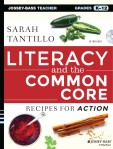 [The following post originally appeared in slightly different form on MiddleWeb on January 7, 2015:]
[The following post originally appeared in slightly different form on MiddleWeb on January 7, 2015:]
In the PARCC literary analysis task, students must closely analyze two literary texts—often focusing on their themes or points of view—and compare and contrast these texts. In previous posts, I’ve proposed a lesson series to tackle this task and a tool for teaching students how to infer theme, which is a common requirement since Common Core Reading Anchor Standard #2 is “Determine central ideas or themes of a text and analyze their development; summarize the key supporting details and ideas.”
This post deals with the challenge of how to organize a compare-and-contrast essay, which many students struggle with, I believe, for two reasons:
- Teachers often rely on Venn diagrams to teach the concept of “compare and contrast,” and Venn diagrams are not a useful way to organize writing. They were meant for discussions around set theory, not for essay writing. Seriously. Could you write an essay from notes inserted into this?
- Teachers tend to assume that students can transfer their “understandings” from Venn diagrams into full-blown essays, so they don’t spend enough time explaining how to outline and develop the evidence and explanation needed.
As I’ve noted previously (here and here), instead of trying to fill in Venn diagrams, students should annotate texts with charts that have either two or three columns (i.e., depending on the number of texts: for literary analysis, it’s two; for research writing, it’s two texts and a video), then put checkmarks next to items that the texts have in common. What remains unchecked should be dealt with in the “contrast” paragraphs.
But you can’t easily write an essay from those notes. You have to organize your ideas.
Here is a simple graphic organizer to help students turn those notes into an outline for writing*:
| Thesis/Argument Statement:
Both ________________________________[Text 1] and _______________________________[Text 2] deal with __________________________________[TOPIC/THEME], but they do so in different ways.
|
What are the different parts of the argument that your essay must prove?
| CONTRAST: How does Text 1 deal with the topic/theme? Explain with 2-3 fully-explained pieces of evidence. | CONTRAST: How does Text 2 deal with the topic/theme? Explain with 2-3 fully-explained pieces of evidence. | COMPARE: What do both texts have in common regarding their approach to the topic/theme? Explain with 2-3 fully-explained pieces of evidence.
|
| 1. | 1. | 1.
|
| 2. | 2. | 2.
|
| 3. | 3. | 3.
|
| Conclusion: Ultimately, both texts help us see/realize __________________________________________[punchy insight].
|
As always, students will need lots of modeling and practice to master this step.
*A free PDF version of this organizer can be downloaded here: Outlining Your Compare-and-Contrast Essay. It can also be found on the TLC “PARCC Prep” page.

Pingback: PARCC Prep: Learning from Failure | The Literacy Cookbook blog
Pingback: PARCC Administration Logistical Tips | The Literacy Cookbook blog
Pingback: PARCC Prep Writing Task Care Packages | The Literacy Cookbook blog
Pingback: Essential Literacy Work Before You Begin Test Prep | The Literacy Cookbook blog
Pingback: PARCC Prep: Literary Analysis Writing Lesson Cycle | The Literacy Cookbook blog
Pingback: CCSS Test Prep: Literary Analysis Writing
Pingback: PARCC Prep: Literary Analysis Writing Lesson Cycle UPDATED, 1-28-2020 | The Literacy Cookbook blog